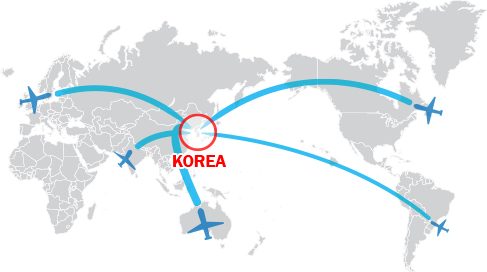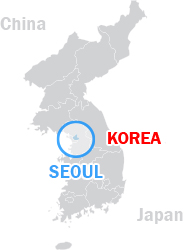- About Korea
- Home > General Infomation > About Korea
Geographical Location of Korea

Korea lies adjacent to China and Japan. The northern border of Korea is formed by the Amnokgang (Yalu) and Dumangang (Tumen) rivers, which separates it from Manchuria. A 16-kilometer segment of the Dumangang to the east also serves as a natural border with Russia. The west coast of the Korean Peninsula is bounded by the Korean Bay to the north and the West Sea to the south; the east coast faces the East Sea. Two hundred kilometers separate the peninsula from eastern China.
The shortest distance between Korean and Chinese coast is 200 kilometers and from the southeastern tip of the peninsula, the nearest point on the Japanese coast is also about 200 kilometers away. Because of its unique geographical location, Chinese culture filtered into Japan through Korea; a common cultural sphere of Buddhism and Confucianism was thus established between the three countries.
The Korean Peninsula extends about 1,000 kilometers southward from the northeast Asian continental landmass. Roughly 300 kilometers in width, climate variations are more pronounced along the south-north axis. Differences in plant vegetation can be seen between the colder north and the warmer south. The peninsula and all of its associated islands lie between 33 06'40"N and 43 00'39"N parallels and 124 11'00"E and 131 52'08"E meridians. The latitudinal location of Korea is similar to that of the Iberian Peninsula and Greece. The entire peninsula corresponds approximately to the north-south span of the state of California. Koreans have developed and use a unique alphabet called Hangeul. It is considered to be one of the most efficient alphabets in the world and has garnered unanimous praise from language experts for its scientific design and excellence.

About Korea
Visitors will discover its rich natural beauty combined with a unique cultural and historical heritage. After a rapid modernization in recent decades, Koreans still maintain their traditional values such as hospitality and the time- honored Confucian respect for the elderly.
Traveling in Korea is enjoyable all year round thanks to its distinct four seasons and the beautiful changes of nature. In spring (March to May), mountains and fields are in bloom with cherry blossoms, forsythias, azaleas, magnolias and lilacs. In summer (June to early September), luxuriant forests, bright green fields and the cobalt blue sea draw people outdoors. In autumn (September to November), cool temperatures and a clear sky make it the most pleasant time of the year in Korea. The mountains all over the country are covered in red and yellow blazing autumn foliage. In winter (December to February), mountain slopes become the place for skiing and snow festivals. Winter in Korea is another delightful season of great amusement.
More than 400 local festivals throughout the year represent colorful facets of the Korean culture. Events that have great appeal to tourists include the Icheon-Gwangju-Yeoju Ceramic Exposition and the sea-splitting Jindo Yeongdeungje Festival. Korea takes pride in many world-renowned cultural assets which UNESCO has designated on its World Cultural Heritage List. They are Changdeokgung royal palace, Hwaseong fortress, Seokguram stone buddha grotto, Bulguksa temple, the Tripitaka Koreana wood block printing plates at Haeinsa temple, Jongmyo shrine in Seoul, the Gochang, Hwasun and Ganghwa dolmen sites, and the Gyeongju remains of Silla Dynasty.

Tax
Value-added tax (VAT) is levied on most goods and services at a standard rate of 10% and is included in the retail price. In tourist hotels, this 10% tax applies to meals and other services and is added into the bill.
Food
Korean food contains less meat than most traditional Western or Chinese cuisine, and features a wide variety of fermented foods, assorted vegetable dishes, and rice. It is very nutritious and is becoming more and more popular around the world for its health benefits. Traditionally, Korean table settings are comprised of a number of side dishes. Family and friends gather around the table and share between themselves, sampling every dish. Only boiled rice and guk (soup) are two items that are not shared. These customs represent the true character of Koreans as being people who prefer to do everything together. (Major Korean Food: Kimchi, Bibimbap, Galbi, Bulgogi, Hanjeongsik)
Language - Hangeul
Hangeul was invented by King Sejong in 1446 with assistance from some scholars to give the people an alphabet that was easy to read and write. Throughout the world, there are some 3,000 spoken languages but roughly only 100 alphabets . Among these, only hangeul was systematically invented without influence from any other language.
Hangeul is a very scientific alphabet and is designated by UNESCO as an important part of the Memory of the World Heritage. As a result of the Korean Wave and Korea 's economic prosperity, desire to learn hangeul and the Korean language is exploding.

| English | Korean | Korean Pronunciation |
| How are you? | 안녕하세요? | Annyeong-haseyo? |
| Thank you. | 감사합니다. | Gamsa-hamnida. |
| Yes. | 예. | Ye. |
| No. | 아니요. | Aniyo. |
| I am sorry. | 미안합니다. | Mian-hamnida. |
| I enjoyed the meal. | 잘 먹었습니다. | Jal mwogeot-sseumnida. |
| Please give me some more of this. | 이것 더 주세요. | Igeot deo juseyo. |
| The check, please. | 계산서 주세요. | Gyesanseo juseyo. |
| Do you take credit cards? | 카드로 계산할 수 있습니까? | Kadeuro gyesan halsu isseumnikka? |
| How much is it? | 얼마입니까? | Eolma-imnikka? |
| It is ________won. | __________원 입니다. | ___________won imnida. |
| 5,000 | 오천 | O-cheon |
| 10,000 | 만 | Man |
| 15,000 | 만오천 | Man-o-cheon |
| 20,000 | 이만 | I-man |
| 30,000 | 삼만 | Sam-man |
| where is the restroom? | 화장실 어디입니까? | Hwajangsil oedi-imnikka |
| Goodbye. | 안녕히 계세요. | Annyeonghi gyeseyo. |
A Clean, Attracive & Global City, Seoul

Seoul has been the capital of Korea for about 600 years, since the time of the Joseon Dynasty (1392-1910). Seoul was referred to as "Han Yang" during the Joseon Dynasty, but after the liberation from Japan in 1945, the newly founded Republic of Korea officially changed its capital city's name to Seoul. Seoul has developed into a bustling metropolis, acting as the hub for political, economic, social, and cultural matters.
The Han River runs through the heart of the city. The river divides the city in two; the northern part of the city is a focal point for culture and history, while the southern part is well known for its business district.
Seoul has hosted many international events including: 1986 Asian Games, 1988 Olympic Games and 2002 Korea/Japan FIFA World Cup. The success of these events has shown people that Korea is truly an international city.